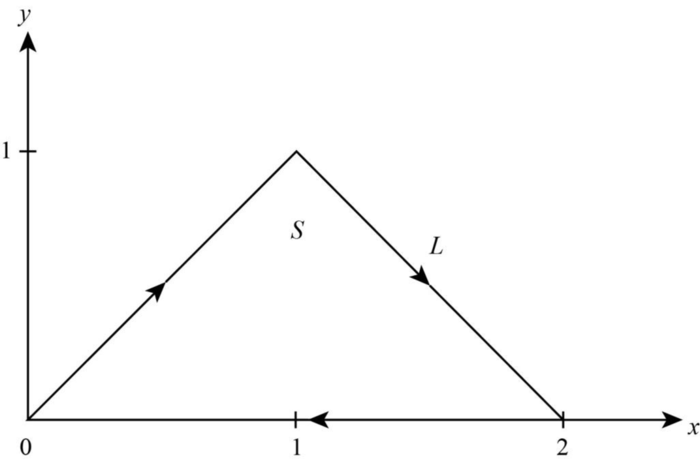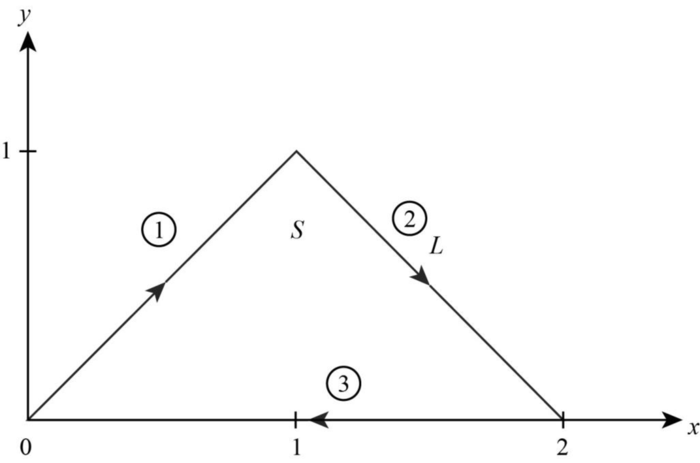
Concept explainers
(a)
The value of the line integral
(a)
Explanation of Solution
Given:
The
The boundaries for

Figure-(1)
Calculation:
The line distribution of the given figure is as shown in figure (2).

Figure-(2)
From the figure (2), the equations for lines
For line
The limit of
Calculate the value of line integral
For line
The limit of
Calculate the value of line integral
For line
The limit of
Calculate the value of line integral
Calculate the value of total line integral
Thus, the value of line integral
(b)
The value of surface integral
(b)
Explanation of Solution
Given:
The vector
The area

Figure-(3)
Calculation:
Calculate the curl of vector
The line distribution of the given figure is as shown in figure-(4).

Figure-(4)
From the figure (2), the equations for line
For line
The limit of
For line
The limit of
Calculate the value of surface integral
Thus, the value of surface integral
(c)
Whether the Stokes’s theorem is satisfied or not.
(c)
Explanation of Solution
The value of line integral
The value of surface integral
The Stokes’s theorem states that if
From the above calculations in subpart (a) and subpart (b), these values are same.
Thus, the Stokes’s theorem is satisfied.
Want to see more full solutions like this?
Chapter 3 Solutions
Elements of Electromagnetics
 Elements Of ElectromagneticsMechanical EngineeringISBN:9780190698614Author:Sadiku, Matthew N. O.Publisher:Oxford University Press
Elements Of ElectromagneticsMechanical EngineeringISBN:9780190698614Author:Sadiku, Matthew N. O.Publisher:Oxford University Press Mechanics of Materials (10th Edition)Mechanical EngineeringISBN:9780134319650Author:Russell C. HibbelerPublisher:PEARSON
Mechanics of Materials (10th Edition)Mechanical EngineeringISBN:9780134319650Author:Russell C. HibbelerPublisher:PEARSON Thermodynamics: An Engineering ApproachMechanical EngineeringISBN:9781259822674Author:Yunus A. Cengel Dr., Michael A. BolesPublisher:McGraw-Hill Education
Thermodynamics: An Engineering ApproachMechanical EngineeringISBN:9781259822674Author:Yunus A. Cengel Dr., Michael A. BolesPublisher:McGraw-Hill Education Control Systems EngineeringMechanical EngineeringISBN:9781118170519Author:Norman S. NisePublisher:WILEY
Control Systems EngineeringMechanical EngineeringISBN:9781118170519Author:Norman S. NisePublisher:WILEY Mechanics of Materials (MindTap Course List)Mechanical EngineeringISBN:9781337093347Author:Barry J. Goodno, James M. GerePublisher:Cengage Learning
Mechanics of Materials (MindTap Course List)Mechanical EngineeringISBN:9781337093347Author:Barry J. Goodno, James M. GerePublisher:Cengage Learning Engineering Mechanics: StaticsMechanical EngineeringISBN:9781118807330Author:James L. Meriam, L. G. Kraige, J. N. BoltonPublisher:WILEY
Engineering Mechanics: StaticsMechanical EngineeringISBN:9781118807330Author:James L. Meriam, L. G. Kraige, J. N. BoltonPublisher:WILEY





